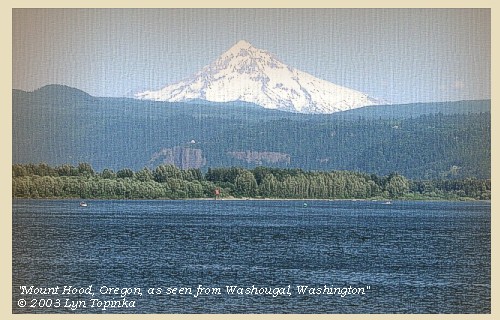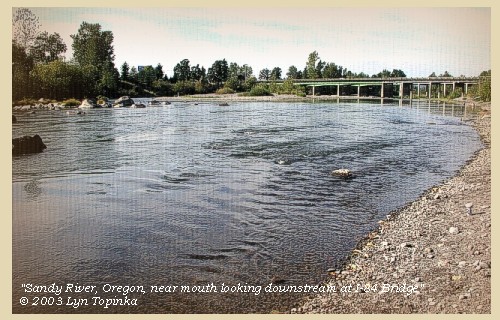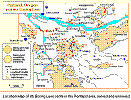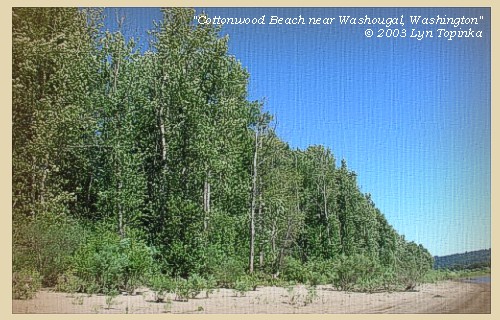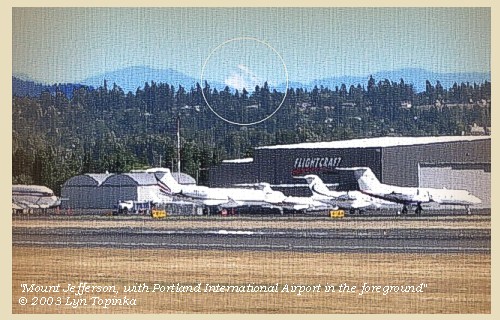The Volcanoes of
Lewis and Clark
Lewis and Clark
|
April 1, 1806 Gathering Provisions - Cottonwood Beach and the Sandy River |
|
Home
The Volcanoes of Lewis and Clark Map of the Journey Volcanoes, Basalt Plateaus, Major Rivers, etc. The Volcanoes Mount Adams, Mount Hood, Mount Jefferson, Mount Rainier, and Mount St. Helens CALENDAR of the Journey October 1805 to June 1806 Along the Journey Pacific Northwest Maps - Columbia River, Volcanoes, Flood Basalts, Missoula Floods, Geology, etc. The Corps of Discovery The Journey of Lewis and Clark About the Reference Materials The Journals, Biddle/Allen, DeVoto, Gass, Moulton, Topo Maps, and others USGS Lewis and Clark Links Links to USGS Websites highlighting the Lewis and Clark Journey Resources Publications Referenced and Websites Visited |
PREVIOUS
March 31 On the Banks of the Columbia, Ryan Point to Cottonwood Beach Camp |
April 1
Gathering Provisions, Cottonwood Beach Camp and the Sandy River Mount Hood, Sandy River, Sandy River in 1805, Lewis and Clark State Recreation Area, Puget Trought and Willamette Valley and Boring Lava Field, Cottonwood Beach, Mount Jefferson |
CONTINUE
April 2 Gathering Privisions, Cottonwood Beach Camp and the Willamette River |
|
Heading for Home - April 1806
Gathering Provisions - Cottonwood Beach and the Sandy River |
| Between March 31 and April 5, 1806 Lewis and Clark camped near present day Cottonwood Beach just upstream of Washougal, Washington. |
| Tuesday, April 1, 1806 |
| Three Indians had followed us yesterday and encamped near us last night. On putting to them a variety of questions relative to their country, they assured us that Quicksand river, [Sandy River - see below] which we had hitherto deemed so considerable, extends no further than the southwest side of mount Hood, which is south 85? east, forty miles distant from this place; |
| that it [Sandy River] is moreover navigable for a very short distance only, in consequence of falls and rapids, and that no nation inhabits its borders. Several other persons affirmed that it rose near mount Hood, and sergeant Pryor, who was sent for the purpose of examining it, convinced us of the truth of their statement. He had found the river three hundred yards wide, though the channel was not more than fifty yards, and about six feet deep. The current was rapid, the water turbid, the bed of the river is formed entirely of quicksand, and the banks low and at present overflowed. He passed several islands, and at three and a half miles distance a creek from the south, fifty yards wide; his farthest course was six miles from the mouth of the river, but there it seemed to bend to the east, and he heard the noise of waterfalls. |
| "... Sergt. Pryor & three men was Sent 5 or 6 miles up Quick Sand River to make discovries & Several hunters went up the Seal River a hunting & others went out in different directions a hunting. a number of the natives visited us as they were passing down the River late in the afternoon Sergt. Pryor returned had been about 4 miles up quick Sand River found the current rapid & only about 4 feet deep ... the hunters tells us that the country back from the River is rich land some praries and rich plains &C. ..." [Ordway, April 1, 1806] |
| If Quicksand river [Sandy River] then does not go beyond mount Hood, it must leave the valley a few miles from its entrance, and run nearly parallel with the Columbia. There must therefore be some other large river, which we have not yet seen, to water the extensive country between the mountains of the coast and Quicksand river [Willamette Valley]: but the Indians could give us no satisfactory information of any such stream. ...... |
| Decided to remain here [Cottonwood Beach Camp] |
| till we collect meat enough to last us till we reach the Chopunnish nation, to obtain canoes from the natives as we ascend, either in exchange for our periougues, or by purchasing them with skins and merchandise. These canoes may in turn be exchanged for horses with the natives of the plains, till we obtained enough to travel altogether by land. On reaching the southeast branch of the Columbia [Snake River], four or five men shall be sent on to the Chopunnish to have our horses in readiness, and thus we shall have a stock of horses sufficient to transport our baggage and to supply us with provisions, for we now perceive that they will form our only certain resource for food. ...... |
|
|
|
The Camp - March 31 through April 5, 1806:
Cottonwood Beach, just upstream of Washougal, Washington. |
| "... we discovred yesterday the top of a high white Mountain some distance to the Southward our officers name it Mount Jefferson ..." [Ordway, April 1, 1806] |
| "... we saw a high mountain laying a great distance off to the Southward of us, which appeared to be covered with snow. Our Officers named this Mountain Jefferson Mountain ..." [Whitehouse, April 1, 1806] |
| While Ordway and Whitehouse entries are on April 1, 1806, Mount Jefferson was actually seen and named on March 30, 1806. |
| Home | Previous | Continue |
If you have questions or comments please contact: GS-CVO-WEB@usgs.gov
June/July 2004, Lyn Topinka
The Volcanoes of Lewis and Clark Home Page | CVO Home Page


